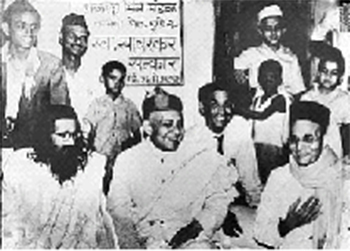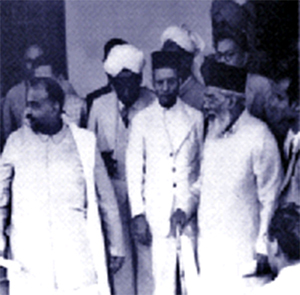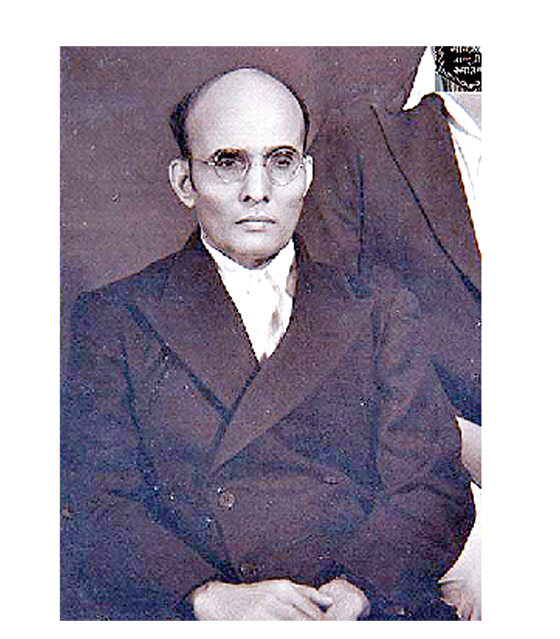Swatantrya Veer Vinayak Damodar Savarkar (May 28, 1883 to February 26 , 1966), who played an important role in India’s Independence, was also social reformer and social revolutionary. His resistance against the British for the freedom of the motherland is well known. Savarkar’s selfless commitment for the motherland could be understood from the fact that in London, he formed the ‘Free India Society’ and continued efforts for India’s Independence among the talented students. Of course, he had to pay a heavy price for this. He was brutally tortured by the British and spent years in jail. Veer Damodar Savarkar was also concerned about the well-being of the Hindu society. He worked against untouchability. In 1931, he established the Patitpavan temple. And, in its trust, there was representation from all castes. Veer Savarkar was also a strategic affairs expert who gave robust defence and diplomatic doctrine.
A social reformer
In a letter written in 1920 from the Andamans, Savarkar wrote, “Just as I feel that I should rebel against foreign rule over Hindusthan, I feel I should rebel against caste discrimination and untouchability.” This letter was written before he had made up his mind to consolidate the Hindus.
Under his direction, in 1931, the Patitpavan temple was established and it had on its trust representation from all castes including “untouchables”. The Patitpavan temple was constructed with the idea that the practise of community prayers at the temple would help to resolve the issue at the other temples. (Samagra Savarkar Vangmaya, Vol- 3, ed. SR Date, Maharashtra Prantik Hindu Sabha, Pune, 1963-1965, Page 492 & More, Sheshrao. Savarkaranchya Samajkrantiche Antarang, Rajhans Publication, Second Editions, 2010, Page 173) At the Patitpavan temple the children from the Mahar, Chambhar, Bhangi communities were taught recitation of Sanskrit hymns alongwith children from the Brahmin, Kshatriya and Vaishya communities. The Abhishek (sprinkling of holy water) for the Vishnu idol would be carried out amidst the chanting of the hymns by these children in what was labelled as a ritual of the entire Hindu community.
Many firsts to his credit
- The first political leader to daringly set absolute political Independence as India’s goal (1900)
- The first Indian political leader to perform a bonfire of foreign (English) clothes (1905)
- The first Indian to organise a revolutionary movement for India’s Independence on an international level (1906)
- The first Indian law student who was not called to the English Bar despite having passed his examination and observed the necessary formalities, for his activities to seek India’s freedom from the British (1909)
- The only Indian leader whose arrest in London caused legal difficulties for British Courts and whose case is still referred to in the interpretations of the Fugitive Offenders Act and the Habeas Corpus (Rex Vs Governor of Brixton Prison, ex-parte Savarkar)
- The first Indian historian whose book on the 1857 War of Independence was proscribed by British Authorities in India even before its publication. The Governor General had asked the Postmaster General to confiscate copies of the book six months before the book was officially banned (1909)
- The first political prisoner whose daring escape and arrest on French soil became a cause celebre in the International Court of Justice at The Hague. This case was mentioned in many International Treaties at that time (1910)
- The first graduate whose degree was withdrawn by an Indian University for striving for India’s freedom (1911)
- The first poet in the world who, deprived of pen and paper, composed his poems and then wrote them on the prison walls with thorns and nails, memorised ten thousand lines of his poetry for years and later transmitted them to India through his fellow prisoners who also memorised these lines
- The first revolutionary leader who within less than 10 years gave a death-blow to the practice of untouchability in the remote district of Ratnagiri while being interned there
- The first Indian leader who successfully started
- A Ganeshotsava open to all Hindus including ex-untouchables (1930)
- Interdining ceremonies of all Hindus including “untouchables” (1931)
- “Patit-PavanMandir”, open to all Hindus including exuntouchables (February 22, 1931)
- A cafe open to all Hindus including “untouchables” (May 1, 1933)
Notably, on February 17 , 1939, Savarkar went to Khulna to attend the Bengal Provincial Hindu Conference. In his Presidential speech, he exhorted those present to eradicate untouchability. He followed words with deed, visiting the house of the “untouchables” leader Shri Dhali, and dining with Doms, B—–s, Namshudras, Patnis and other ex-untouchables. The Amrit Bazaar Patrika in an editorial said hundreds of untouchable brethren were overwhelmed on thus seeing Savarkar join in inter-caste dining and came with folded hands to catch a glimpse of him.
A Revolutionary
Savarkar played a significant role in putting forth the case for India’s Independence on the international scene. He fearlessly went to the enemy camp and carried out his revolutionary activities in the heart of the British Empire. Barrister Sardar Singh Rana (born April 12, 1870, in Katharia in Saurashtra) had announced three travelling fellowships of Rs. 2000 each. These fellowships were named after Maharana Pratap, Chhatrapati Shivaji and Akbar. Savarkar received the Shivaji fellowship on the recommendation of Lokmanya Tilak and Kaal editor Shivrampant Paranjpe. As had been decided, Tilak paid the first installment of Rs 400. Savarkar was to initially leave India on May 26, 1907. However, this plan changed. Finally, on June 9, 1909, Savarkar embarked on SS Persia and reached London on June 24, 1906.
Savarkar came to London to observe at first hand, the strengths of the British people which enabled them to rule over India and also to note their weaknesses and to think of ways of using them to achieve India’s freedom.
Most historians, British as well as Indian, have described and dismissed the rising of 1857 as a ‘Sepoy Mutiny’ or at best ‘The Indian Mutiny’. Indian revolution is on the other hand, and national minded leaders thinkers have regarded it as a planned and organised political and military rising aimed at destroying the British power in India.
Savarkar attempted to look at the incidents of 1857 from the Indian point of view. A leading revolutionary himself, he was attracted and inspired by the burning zeal, the heroism, bravery, suffering and tragic fate of the leaders of 1857, and he decided to re-interpret the story and to relate it in full with the help of all the material available to him at the time. He spent days and months at the India Office Library studying the period. Savarkar wrote this book originally in Marathi and completed writing it in 1908. As it was impossible to get this book published in India, the manuscript was returned back to Savarkar. Attempts to get this book published in Germany also failed. Some Indian students staying in India House translated this book into English. Finally, this work was published in Holland in 1909, under the title “The Indian War of Independence –1857”.

A Literary-Poet
In 1909, Savarkar wrote a poetic letter of consolation from London to his dear sister-in-law Yesuvahini. She had earlier written to him expressing anguish at the arrest of Savarkar’s youngest brother Narayanrao. Days earlier on November 21, 1909, the higher court had confirmed the prison sentence to Yesuvahini’s own husband Babarao. Savarkar himself was in London. It was Yesuvahini who was single-handedly bearing the brunt of the Government’s onslaught. This remarkable letter titled Saantvan (Consolation) is a landmark in Marathi literature.
Savarkar wrote:
Many a flower blooms and withers away
Who has kept their count or note
But behold, the lotus flower that was plucked by Gajendra’s trunk
And offered at the feet of Srihari and thus withered away there
Became immortal and holy effecting moksha (deliverance)
Thus is our Mother Bharat like the pious Gajendra seeking deliverance
Let her come to our garden and offer our dark blue black lotus flower
And pluck it from the bough to offer it at the feet of Sri Rama.
Blessed indeed is our family tree, definitely touched by the divine
In as much as it is privileged to serve Sri Rama
A Rationalist
His View on Cow protection
Given below is an English translation of Savarkar’s assorted views on cow-protection and cow-worship.
Gratitude to the cow is consistent with the Hindu trait of compassion towards all living beings
…That we should look upon that extremely useful animal (cow) with the same affection as for a family member is no doubt in keeping with humanism. To protect and sustain the cow is our personal and familial duty. At least in the case of Hindusthan, it is also our national duty.
…To have a feeling of gratitude towards an animal that is so useful to us is particularly consistent with the Hindu trait of compassion towards all living beings. (1936, vidnyannishthanibandha or pro-science essays, SamagraSavarkarvangmaya, Vol. 3, p.340)
Cow is worthy of protection so long as this serves humanitarian and national interests
Animals such as the cow and buffalo and trees such as banyan and peepal are useful to man, hence we are fond of them; to that extent we might even consider them worthy of worship; their protection, sustenance and well-being is our duty, in that sense alone it is also our dharma! Does it not follow then that when under certain circumstances, that animal or tree becomes a source of trouble to mankind, it ceases to be worthy of sustenance or protection and as such its destruction is in humanitarian or national interests and becomes a human or national dharma? (Samaj Chitre or portraits of society, Samagra Savarkarvangmaya, Vol. 2, p.678)
A Strategist
Ever since the Communist Party of China (CPC) came to power in the People’s Republic of China (PRC), its leaders decided to occupy Tibet. While India’s Prime Minister Jawaharlal Nehru was explaining in the Indian Parliament the difference between the suzerainty and sovereignty (Nehru, Jawaharlal. India’s Foreign Policy, The Publication Division- Ministry of Information & Broadcasting, Government of India, 1961, Page 302), the Chinese armies marched into Tibet in 1950. Nehru made Panchsheel, or the Five Principles of Peaceful Co-existence agreement with China which was signed on April 29, 1954. The representative of the Kesari newpaper of Pune requested Savarkar to write an article on India’s defense and strategic policy which was published on January 26, 1954. Savarkar writes: “When China, without even consulting India, invaded the buffer state of Tibet, India should at once have protested and demanded the fulfilment of rights and privileges as per her agreements and pacts entered into with Tibet. But our Indian Government was not able to do any such thing. We closed our eyes in the name of world peace and co-existence and did not even raise a finger against this invasion of Tibet. Neither did we help this buffer state of Tibet when her very existence was at stake. Why? The only reason that I visualise is our unpreparedness for such an eventuality and/or war..……That is the reason why after swallowing the whole of Tibet the strong armies of China and Russia are now standing right on our borders in a state of complete preparedness and on the strength of the above, China is today openly playing the game of liquidating the remaining buffer states of Nepal and Bhutan.……We have not been able to put before her an army which can match the strength of her armies on these borders of ours even today. This is precisely the reason why China dares come forward with such an unabashed claim on our territories.”
A patriot
In 1902, when the coronation of Edward VII was being celebrated in the British colonies, Tarun Savarkar opposed it in his district. He was against our participation in the celebration of those who enslaved our country. In 1904, he founded an organisation called ‘Abhinav Bharat’, whose purpose was to oppose British rule. Leading the youth in 1905, he opposed the dissolution of the partition based on religion by Lord Curzon all over Maharashtra.

Prisoner of Kaala Paani Veer’s darkest phase was from 1911 to 1921, when he was imprisoned in Kaala Paani- the prison of the Andaman Islands. His concern was not the detention, but what bothered him the most was his distance from his motherland. The prisoners of Kaala Paani were turned into slaves and were made to work in inhumane conditions. Everyone who entered Kaala Paani knew that their lives had entered a dark and horrific abyss. Slaves who were treated worse than animals were forced to eat rotten food, which would often smell of vomit and even be cooked with rotten insects. This is the worst torture any human can be made to go through. Prison cells had no proper washrooms and an indecent defecation system which was also unhygienic and gross beyond imagination. Some of the details about Kaala Paani can actually be petrifying for the readers. Prisoners were forced to do manual labour for 18 hours a day, and people would often fall dead while working midday. There was no room for healthcare or giving a holiday to a sick person, obviously. Forced labour was a torturous way of painfully killing the enemies of the British Empire. Since the Andaman Islands were cut off from the rest of the world, hardly anyone noticed what really happened in Kaala Paani. The only hope which kept Savarkar and some other patriots alive was that someday they should return to Bharat and begin again with their freedom struggle and get the honour of working in the interests of the people of Bharat. Veer Savarkar spent 13 years in Kaala Paani, and each day was a living hell.



















Comments